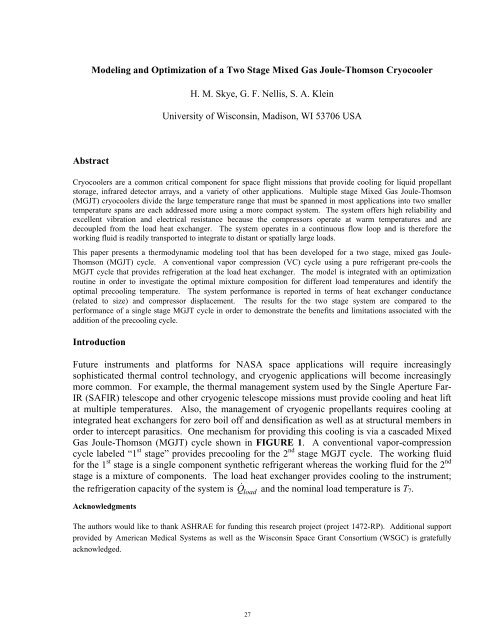Space Grant Consortium - University of Wisconsin - Green Bay
Space Grant Consortium - University of Wisconsin - Green Bay
Space Grant Consortium - University of Wisconsin - Green Bay
Create successful ePaper yourself
Turn your PDF publications into a flip-book with our unique Google optimized e-Paper software.
Modeling and Optimization <strong>of</strong> a Two Stage Mixed Gas Joule-Thomson Cryocooler<br />
Abstract<br />
H. M. Skye, G. F. Nellis, S. A. Klein<br />
<strong>University</strong> <strong>of</strong> <strong>Wisconsin</strong>, Madison, WI 53706 USA<br />
Cryocoolers are a common critical component for space flight missions that provide cooling for liquid propellant<br />
storage, infrared detector arrays, and a variety <strong>of</strong> other applications. Multiple stage Mixed Gas Joule-Thomson<br />
(MGJT) cryocoolers divide the large temperature range that must be spanned in most applications into two smaller<br />
temperature spans are each addressed more using a more compact system. The system <strong>of</strong>fers high reliability and<br />
excellent vibration and electrical resistance because the compressors operate at warm temperatures and are<br />
decoupled from the load heat exchanger. The system operates in a continuous flow loop and is therefore the<br />
working fluid is readily transported to integrate to distant or spatially large loads.<br />
This paper presents a thermodynamic modeling tool that has been developed for a two stage, mixed gas Joule-<br />
Thomson (MGJT) cycle. A conventional vapor compression (VC) cycle using a pure refrigerant pre-cools the<br />
MGJT cycle that provides refrigeration at the load heat exchanger. The model is integrated with an optimization<br />
routine in order to investigate the optimal mixture composition for different load temperatures and identify the<br />
optimal precooling temperature. The system performance is reported in terms <strong>of</strong> heat exchanger conductance<br />
(related to size) and compressor displacement. The results for the two stage system are compared to the<br />
performance <strong>of</strong> a single stage MGJT cycle in order to demonstrate the benefits and limitations associated with the<br />
addition <strong>of</strong> the precooling cycle.<br />
Introduction<br />
Future instruments and platforms for NASA space applications will require increasingly<br />
sophisticated thermal control technology, and cryogenic applications will become increasingly<br />
more common. For example, the thermal management system used by the Single Aperture Far-<br />
IR (SAFIR) telescope and other cryogenic telescope missions must provide cooling and heat lift<br />
at multiple temperatures. Also, the management <strong>of</strong> cryogenic propellants requires cooling at<br />
integrated heat exchangers for zero boil <strong>of</strong>f and densification as well as at structural members in<br />
order to intercept parasitics. One mechanism for providing this cooling is via a cascaded Mixed<br />
Gas Joule-Thomson (MGJT) cycle shown in FIGURE 1. A conventional vapor-compression<br />
cycle labeled “1 st stage” provides precooling for the 2 nd stage MGJT cycle. The working fluid<br />
for the 1 st stage is a single component synthetic refrigerant whereas the working fluid for the 2 nd<br />
stage is a mixture <strong>of</strong> components. The load heat exchanger provides cooling to the instrument;<br />
the refrigeration capacity <strong>of</strong> the system is Qload � and the nominal load temperature is T7.<br />
Acknowledgments<br />
The authors would like to thank ASHRAE for funding this research project (project 1472-RP). Additional support<br />
provided by American Medical Systems as well as the <strong>Wisconsin</strong> <strong>Space</strong> <strong>Grant</strong> <strong>Consortium</strong> (WSGC) is gratefully<br />
acknowledged.<br />
27

















